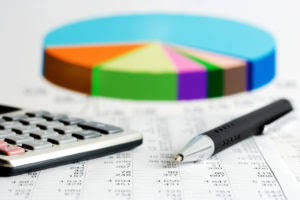
Use our coefficient of determination calculator to find the so-called R-squared of any two variable dataset. If you’ve ever wondered what the coefficient of determination is, keep reading, as we will give you both the R-squared formula and an what are the five basic accounting assumptions top 5 accounting principles explanation of how to interpret the coefficient of determination. We also provide an example of how to find the R-squared of a dataset by hand, and what the relationship is between the coefficient of determination and Pearson correlation.
Relative error
- One aspect to consider is that r-squared doesn’t tell analysts whether the coefficient of determination value is intrinsically good or bad.
- Unlike R2, which will always increase when model complexity increases, R2 will increase only when the bias that eliminated by the added regressor is greater than variance introduced simultaneously.
- A value of 1.0 indicates a 100% price correlation and is thus a reliable model for future forecasts.
- For the adjusted R2 specifically, the model complexity (i.e. number of parameters) affects the R2 and the term / frac and thereby captures their attributes in the overall performance of the model.
Let’s take a look at Minitab’s output from the height and weight example (university_ht_wt.TXT) that we have been working with in this lesson. For instance, if you were to plot the closing prices for the S&P 500 and Apple stock (Apple is listed on the S&P 500) for trading days from Dec. 21, 2022, to Jan. 20, 2023, you’d collect the prices as shown in the table below. About \(67\%\) of the variability in the value of this vehicle can be explained by its age.
In a multiple linear model
Most of the time, the coefficient of determination is denoted as R2, simply called “R squared”. Because 1.0 demonstrates a high correlation and 0.0 shows no correlation, 0.357 shows that Apple stock price movements are somewhat correlated to the index. So, a value of 0.20 suggests that 20% of an asset’s price movement can be explained by the index, while a value of 0.50 indicates that 50% of its price movement can be explained by it, and so on. We want to report this in terms of the study, so here we would say that 88.39% of the variation in vehicle price is explained by the age of the vehicle.
Coefficient of Determination: How to Calculate It and Interpret the Result
The explanation of this statistic is almost the same as R2 but it penalizes the statistic as extra variables are included in the model. For cases other than fitting by ordinary least squares, the R2 statistic can be calculated as above and may still be a useful measure. If fitting is by weighted least squares or generalized least squares, alternative versions of R2 can be calculated appropriate to those statistical frameworks, while the “raw” R2 may still be useful if it is more easily interpreted.

Values for R2 can be calculated for any type of predictive model, which need not have a statistical basis. The coefficient of determination is a ratio that shows how dependent one variable is on another variable. Investors use it to determine how correlated an asset’s price movements are with its listed index. As with linear regression, it is impossible to use R2 to determine whether one variable causes the other. In addition, the coefficient of determination shows only the magnitude of the association, not whether that association is statistically significant.
In statistics, the coefficient of determination, denoted R2 or r2 and pronounced “R squared”, is the proportion of the variation in the dependent variable that is predictable from the independent variable(s). The coefficient of determination shows how correlated one dependent and one independent variable are. Once you have the coefficient of determination, https://www.kelleysbookkeeping.com/why-the-quick-ratio-is-important/ you use it to evaluate how closely the price movements of the asset you’re evaluating correspond to the price movements of an index or benchmark. In the Apple and S&P 500 example, the coefficient of determination for the period was 0.347. If our measure is going to work well, it should be able to distinguish between these two very different situations.
However, since linear regression is based on the best possible fit, R2 will always be greater than zero, even when the predictor and outcome variables bear no relationship to one another. Coefficient of determination, in statistics, R2 (or r2), a measure that assesses the ability of a model to predict or explain an outcome in the linear regression setting. More specifically, R2 indicates the proportion of the variance in the dependent variable (Y) that is predicted or explained by linear regression and the predictor variable (X, also known as the independent variable). The adjusted R2 can be interpreted as an instance of the bias-variance tradeoff. When we consider the performance of a model, a lower error represents a better performance. When the model becomes more complex, the variance will increase whereas the square of bias will decrease, and these two metrices add up to be the total error.
A value of 0.0 suggests that the model shows that prices are not a function of dependency on the index. Scott Nevil is an experienced freelance writer and editor with a demonstrated history of publishing content for The Balance, Investopedia, and ClearVoice. He goes in-depth to create informative and actionable content around monetary policy, https://www.kelleysbookkeeping.com/ the economy, investing, fintech, and cryptocurrency. Marine Corp. in 2014, he has become dedicated to financial analysis, fundamental analysis, and market research, while strictly adhering to deadlines and AP Style, and through tenacious quality assurance. Remember, for this example we found the correlation value, \(r\), to be 0.711.
When considering this question, you want to look at how much of the variation in a student’s grade is explained by the number of hours they studied and how much is explained by other variables. Realize that some of the changes in grades have to do with other factors. You can have two students who study the same number of hours, but one student may have a higher grade.
Where Xi is a row vector of values of explanatory variables for case i and b is a column vector of coefficients of the respective elements of Xi. For example, the practice of carrying matches (or a lighter) is correlated with incidence of lung cancer, but carrying matches does not cause cancer (in the standard sense of “cause”). Values of R2 outside the range 0 to 1 occur when the model fits the data worse than the worst possible least-squares predictor (equivalent to a horizontal hyperplane at a height equal to the mean of the observed data). This occurs when a wrong model was chosen, or nonsensical constraints were applied by mistake. If equation 1 of Kvålseth[12] is used (this is the equation used most often), R2 can be less than zero.
Based on bias-variance tradeoff, a higher model complexity (beyond the optimal line) leads to increasing errors and a worse performance. R2 can be interpreted as the variance of the model, which is influenced by the model complexity. A high R2 indicates a lower bias error because the model can better explain the change of Y with predictors. For this reason, we make less (erroneous) assumptions, and this results in a lower bias error. Meanwhile, to accommodate less assumptions, the model tends to be more complex. Based on bias-variance tradeoff, a higher complexity will lead to a decrease in bias and a better performance (below the optimal line).
As a reminder of this, some authors denote R2 by Rq2, where q is the number of columns in X (the number of explanators including the constant). On the other hand, the term/frac term is reversely affected by the model complexity. The term/frac will increase when adding regressors (i.e. increased model complexity) and lead to worse performance.
These two trends construct a reverse u-shape relationship between model complexity and R2, which is in consistent with the u-shape trend of model complexity vs. overall performance. Unlike R2, which will always increase when model complexity increases, R2 will increase only when the bias that eliminated by the added regressor is greater than variance introduced simultaneously. A statistics professor wants to study the relationship between a student’s score on the third exam in the course and their final exam score.

